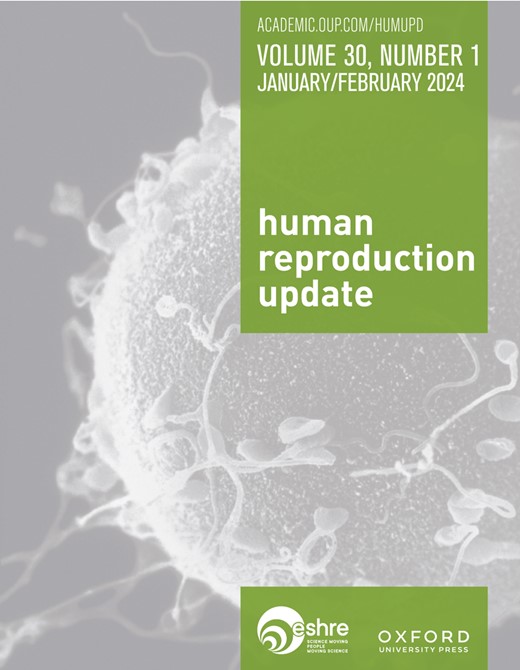Impact of Bisphenol A and its alternatives on oocyte health: a scoping review
IF 16.1
1区 医学
Q1 OBSTETRICS & GYNECOLOGY
引用次数: 0
Abstract
BACKGROUND Bisphenol A (BPA) is an endocrine disrupting chemical released from plastic materials, including food packaging and dental sealants, persisting in the environment and ubiquitously contaminating ecosystems and human populations. BPA can elicit an array of damaging health effects and, alarmingly, ‘BPA-free’ alternatives mirror these harmful effects. Bisphenol exposure can negatively impact female fertility, damaging both the ovary and oocytes therein. Such damage can diminish reproductive capacity, pregnancy success, and offspring health. Despite global government regulations in place to indicate ‘safe’ BPA exposure levels, these policies have not considered the effects of bisphenols on oocyte health. OBJECTIVE AND RATIONALE This scoping review was conducted to evaluate evidence on the effects of BPA and BPA alternatives on standardized parameters of oocyte health. In doing so, this review addresses a critical gap in the literature providing a comprehensive, up-to-date synthesis of the effects of bisphenols on oocyte health. SEARCH METHODS This scoping review was conducted in accordance with PRISMA guidelines. Four databases, Medline, Embase, Scopus, and Web of Science, were searched twice (23 February 2022 and 1 August 2023) to capture studies assessing mammalian oocyte health post-bisphenol exposure. Search terms regarding oocytes, ovarian follicles, and bisphenols were utilized to identify relevant studies. Manuscripts written in English and reporting the effect of any bisphenol on mammalian oocyte health from all years were included. Parameters for toxicological studies were evaluated, including the number of bisphenol concentrations/doses tested, dosing regimen, biological replicates and/or animal numbers, and statistical information (for human studies). Standardized parameters of oocyte health including follicle counts, oocyte yield, oocyte meiotic capacity, morphology of oocyte and cumulus cells, and oocyte meiotic spindle integrity were extracted across the studies. OUTCOMES After screening 3147 studies, 107 studies of either humans or mammalian animal models or humans were included. Of the in vitro exposure studies, 96.3% (26/27) and 94.1% (16/17) found at least one adverse effect on oocyte health using BPA or BPA alternatives (including BHPF, BPAF, BPB, BPF, and BPS), respectively. These included increased meiotic cell cycle arrest, altered morphology, and abnormal meiotic spindle/chromosomal alignment. In vivo, 85.7% (30/35) of studies on BPA and 92.3% (12/13) on BPA alternatives documented adverse effects on follicle development, morphology, or spindle/chromosome alignment. Importantly, these effects were recorded using levels below those deemed ‘safe’ for human exposure. Over half (11/21) of all human observational studies showed associations between higher urinary BPA levels and reduced antral follicle counts or oocyte yield in IVF patients. Recommendations are presented based on the identified shortcomings of the current evidence, incorporating elements of FDA requirements for future research in the field. WIDER IMPLICATIONS These data highlight the detrimental impacts of low-level BPA and BPA alternative exposure, contributing to poor oocyte quality and reduced fertility. These outcomes are valuable in promoting the revision of current policies and guidelines pertaining to BPA exposure internationally. This study serves as a valuable resource to scientists, providing key recommendations on study design, reporting elements, and endpoint measures to strengthen future studies. Ultimately, this review highlights oocyte health as a fundamentally important endpoint in reproductive toxicological studies, indicating an important direction for future research into endocrine disrupting chemicals to improve fertility outcomes.双酚 A 及其替代品对卵母细胞健康的影响:范围审查
背景 双酚 A(BPA)是一种干扰内分泌的化学物质,从食品包装和牙科密封剂等塑料材料中释放出来,长期存在于环境中,对生态系统和人类造成普遍污染。双酚 A 可对健康产生一系列有害影响,令人震惊的是,"不含双酚 A "的替代品也反映了这些有害影响。接触双酚会对女性的生育能力产生负面影响,损害卵巢和卵细胞。这种损害会降低生殖能力、怀孕成功率和后代健康。尽管全球政府都制定了相关法规来说明双酚 A 暴露的 "安全 "水平,但这些政策并未考虑双酚对卵母细胞健康的影响。目标和理由 本次范围界定审查旨在评估双酚 A 和双酚 A 替代品对卵母细胞健康标准参数影响的证据。在此过程中,本综述填补了文献中的一个重要空白,就双酚对卵母细胞健康的影响提供了全面、最新的综述。搜索方法 本次范围界定综述根据 PRISMA 指南进行。对 Medline、Embase、Scopus 和 Web of Science 四个数据库进行了两次检索(2022 年 2 月 23 日和 2023 年 8 月 1 日),以获取评估双酚暴露后哺乳动物卵母细胞健康状况的研究。利用有关卵母细胞、卵巢滤泡和双酚的检索词来确定相关研究。收录了用英语撰写的、报告任何双酚对哺乳动物卵母细胞健康影响的历年研究报告。对毒理学研究的参数进行了评估,包括测试的双酚浓度/剂量的数量、剂量方案、生物重复和/或动物数量以及统计信息(针对人类研究)。在所有研究中提取了卵母细胞健康的标准化参数,包括卵泡计数、卵母细胞产量、卵母细胞减数分裂能力、卵母细胞和积层细胞的形态以及卵母细胞减数分裂纺锤体的完整性。结果 筛选了 3147 项研究后,纳入了 107 项关于人类或哺乳动物模型或人类的研究。在体外暴露研究中,分别有 96.3% (26/27)和 94.1% (16/17)的研究发现,使用双酚 A 或双酚 A 替代品(包括双酚 A、双酚 AF、双酚 B、双酚 F 和双酚 S)至少会对卵母细胞健康产生一种不利影响。这些影响包括减数分裂细胞周期停滞、形态改变和减数分裂纺锤体/染色体排列异常。在体内,85.7%(30/35)关于双酚 A 的研究和 92.3%(12/13)关于双酚 A 替代品的研究记录了对卵泡发育、形态或纺锤体/染色体排列的不利影响。重要的是,这些影响都是在低于人体接触 "安全 "水平的情况下产生的。在所有人类观察性研究中,有一半以上(11/21)的研究表明,尿液中双酚 A 水平升高与体外受精患者前卵泡数或卵母细胞产量减少有关。根据已发现的现有证据的不足之处,并结合美国食品及药物管理局(FDA)对该领域未来研究的要求,提出了相关建议。更广泛的影响 这些数据强调了低水平双酚 A 和双酚 A 替代品暴露的有害影响,导致卵母细胞质量差和生育能力下降。这些结果对于推动国际社会修订与双酚 A 暴露相关的现行政策和指导方针具有重要价值。本研究为科学家提供了宝贵的资源,就研究设计、报告要素和终点测量提供了重要建议,以加强未来的研究。最终,本综述强调了卵母细胞健康是生殖毒理学研究中的一个基本重要终点,为今后研究干扰内分泌的化学品以改善生育结果指明了一个重要方向。
本文章由计算机程序翻译,如有差异,请以英文原文为准。
求助全文
约1分钟内获得全文
求助全文
来源期刊

Human Reproduction Update
医学-妇产科学
CiteScore
28.80
自引率
1.50%
发文量
38
期刊介绍:
Human Reproduction Update is the leading journal in its field, boasting a Journal Impact FactorTM of 13.3 and ranked first in Obstetrics & Gynecology and Reproductive Biology (Source: Journal Citation ReportsTM from Clarivate, 2023). It specializes in publishing comprehensive and systematic review articles covering various aspects of human reproductive physiology and medicine.
The journal prioritizes basic, transitional, and clinical topics related to reproduction, encompassing areas such as andrology, embryology, infertility, gynaecology, pregnancy, reproductive endocrinology, reproductive epidemiology, reproductive genetics, reproductive immunology, and reproductive oncology. Human Reproduction Update is published on behalf of the European Society of Human Reproduction and Embryology (ESHRE), maintaining the highest scientific and editorial standards.
 求助内容:
求助内容: 应助结果提醒方式:
应助结果提醒方式:


